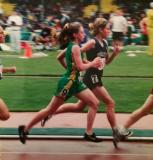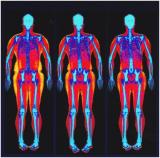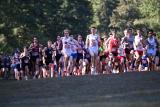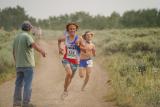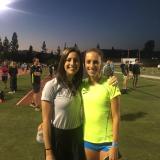Folders |
Running Issues: Puberty 101Published by
A Deeper Dive Into The Critical Phase In An Athlete's Development By Elizabeth Carey for DyeStat Have you heard that puberty is the one “injury” female athletes can’t come back from? Have you heard it is detrimental to girls’ performance and good for boys’? Or that when girls get “hips and boobs” their competitive running days are pretty much over? Or have you heard nothing much about it? Puberty is when a child’s body matures into adulthood and gains reproductive capabilities and it is often seen as taboo. Myths about it still circulate. Yet puberty is an important rite of passage for everyone. Despite what you might’ve heard (or not), puberty is crucial for all athletes, of any gender, sex, size, shape, and identity. It includes lots of changes — physical, mental, emotional, social, cultural. The truth is our bodies are always changing. From birth to death, and even after that, cells and bones and brains fluctuate. Technically, puberty is simply another phase. The stories we tell about puberty, though, add extra charge. Especially for girls, who operate in a sporting environment that was built by men for men and boys, as Lauren Fleshman, former pro runner, coach and author, has said. So let’s take a quick look at what puberty actually entails and what it means for athletes. The following sums up research I’ve done for Girls Running, the book I wrote with Melody Fairchild, and since then, including sourced interviews, studies, and specialists’ presentations. I’m no doctor or registered dietitian or endocrinologist or psychologist or any of the other experts who should be consulted with any concerns. Even as wide-scale research on a diverse range of female athletes is lacking, specialists are pushing conversations (and questions) forward. There’s always more to learn. Physically, puberty kicks off with new growth and development of sex characteristics. For girls, this generally starts between ages 8 and 13; for boys, between 9 and 15. Both of those ranges seem like a big swing, and they are. Every body is different! Plus, development is affected by genetics, health and stress. Surging hormones invite physical changes. See: human growth hormone and the hypothalamic-pituitary-gonadal axis, which is responsible for reproductive functions. Around this time, an individual athlete might notice pubic hair and growth in breasts or testicles. As breasts develop, they may affect how training feels, which can be improved with a very important piece of equipment: a comfortable sports bra. Through puberty, body composition fluctuates, with changes in body fat and lean mass, as athletes gain height and weight. In fact, puberty is when athletes gain most of their height and, significantly for long-term health, bone mineral density. Lungs, hearts and brains continue to develop. Sleep and energy needs surge. Hormones affect mood and cognition, too. All these factors affect how one feels (and moves) in their own skin. It can take a bit to adjust to this (See: proprioception). Psst, coaches, remember it’s just a phase, one that you can help usher athletes through. Athletes who menstruate start, on average, at age 13. This, too, is an important rite of passage with implications for short- and long-term health, development and performance (Think: bone health, metabolism, fertility). The menstrual cycle has its own rhythmic set of symptoms, including potential discomfort (Hey-o, cramps, bloating, fatigue) and positives (mood boosts, metabolic changes). The period (bleeding) a healthy menstrual cycle brings is a vital sign for female athletes. Research elucidates top risks for athletes in and around puberty. Low energy availability and the complications it leads to with Relative Energy Deficiency in Sport, aka RED-S, is common, and often an unintentional result of not meeting increased energy demands. Other issues include bone issues (stress fractures, low density) and hormonal disturbances. What’s more, puberty coincides with the time when serious mental health issues may arise. Reported symptoms of depression, anxiety, and suspected suicide attempts among adolescents have increased since 2019. If that’s not enough, athletes who are navigating puberty face pressures around body image and identity. Thanks to gender inequality (Yes, girls still lack the athletic resources that boys have access to) and discrimination against minoritized identities, additional obstacles pop up. So, are there differences between peri-pubertal experiences for athletes on the girls and boys rosters? 100 percent. Are there individual differences as well? Yep. Considering all of this, are plateaus possible, especially for girls? Sure. Are they permanent? No. BTW, has any athlete’s performance trajectory looked like a straight line up? Almost never. Should we fear, shun, or shirk puberty and the changes it brings? Immediately no. Rather, let’s prepare for and accept potential changes. Let’s, as Fairchild has been saying for decades, embrace the power and wisdom of our own bodies. When athletes are supported holistically — especially with sleep, food, thoughtful training, adequate recovery, education, empowerment — puberty becomes, perhaps, a layover on a long journey. When athletes are supported, they can and do emerge from puberty stronger and faster, with improved resiliency and self-awareness. That is, if we — coaches, parents, peers, hobby jogging relatives — get out of their way. If we stop telling them to avoid body changes and cease saying they should expect to slow down indefinitely after, say, a sophomore slump. It’s time we stop limiting their potential. Puberty needn’t be the end of the road for female athletes. Rather, it’s a beginning. Remember, as Fleshman reminded coaches at a recent Wildwood Running conference, it’s women, not prepubescent girls, who set world records. ### Elizabeth Carey (https://elizabethwcarey.com/) is a writer and running coach based in Seattle, Washington. Her first book, GIRLS RUNNING, co-authored with Melody Fairchild, is available at your local bookstore and here: https://shop.aer.io/GirlsRunning/p/Girls_Running_All_You_Need_to_Strive_Thrive_and_Run_Your_Best/9781948007184-9934. More news |

